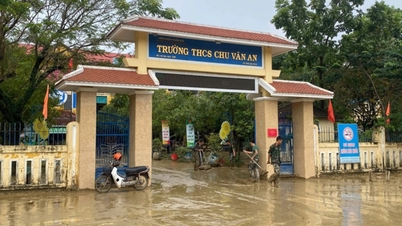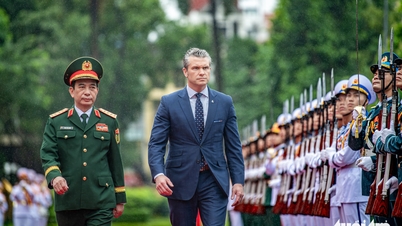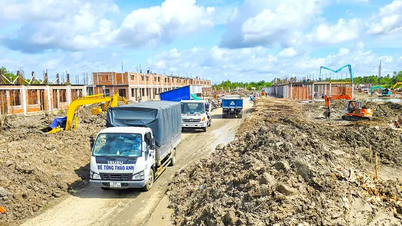
Building resilience for education in disadvantaged areas
In the first 10 months of 2025 alone, 11 storms swept through provinces and cities in our country, causing serious damage to the education sector. More than 1,000 facilities were affected, hundreds of schools had their roofs blown off, thousands of classrooms were damaged; storm No. 10 (Bualoi) in late September alone caused Ha Tinh to lose more than 429 billion VND, Nghe An more than 300 billion VND, many buildings had collapsed walls, had their roofs blown off, and equipment on the first floor was flooded and damaged.
In the northern mountainous region, the rains of up to 300 mm/day caused landslides and deep flooding of dozens of schools in Lao Cai, Tuyen Quang, Cao Bang, and Lang Son; many classrooms had to be evacuated and taught temporarily in conditions of lack of electricity and clean water. After the storm, the corrugated iron roofs could be rebuilt, new classrooms could be built, but the "internal wounds" of education in difficult areas have not yet healed. Thousands of makeshift classrooms on weak ground, many schools located in landslide areas, do not meet safety standards; equipment, desks, chairs, and computers can easily be swept away after just one heavy rain.
From that reality, the lesson is: Education in disadvantaged areas must proactively build resilience, starting from planning, infrastructure, governance to people.
After storm No. 10, the Ministry of Education and Training directed localities to review and assess the safety of each school; coordinate with the construction and environmental resources sectors to determine the location, foundation, materials, and form new standards for "safe schools in natural disasters". Some provinces have proactively relocated schools from landslide areas, using lightweight materials, sloping roofs, high foundations, and good drainage, demonstrating risk prevention thinking from the design stage.
At the same time, flexible management capacity is considered the key to maintaining teaching and learning: Many schools have prepared response scenarios, promptly switched to online learning, organized temporary classes, and "consolidated classes" to avoid program disruption. However, the differences in guidance between localities show the need to build a unified response scenario and an industry-wide early warning system.
Besides infrastructure and governance, people are still the decisive factor in education’s resilience. Disaster prevention content has been integrated into the main curriculum; students need to be trained in awareness, shelter, first aid, and evacuation skills; teachers and administrators are trained in “safe schools”.
When infrastructure is strengthened, governance is flexible enough and people are equipped with skills, education in disadvantaged areas will gradually become more sustainable. But for efforts to not only stop at "overcoming difficulties" but also transform into a driving force for sustainable development, a strong enough policy framework is needed to support, energize and replicate this spirit, as the entire political system has joined hands in the recent storms.
The policy has "touched", but not "permeated"
In recent times, many important policies have been issued to strengthen the protection and support of education in disadvantaged areas. Policy thinking is shifting from response to creation, from individual, short-term support to a comprehensive, sustainable approach. In Tuyen Quang, the initial effects are clear: The rate of mobilizing 3-5 year old preschool children reached more than 99%, among the highest in the country.
However, behind that achievement there are still many difficulties. Mau Long Kindergarten (Mau Due Commune, Tuyen Quang Province) has 12 separate locations, more than 660 children, but only 38 teachers; each classroom is a room of about 42 square meters, less than half of the standard area according to regulations. "With 160,000 VND/child/month, we can only take care of enough meals, not enough nutrition," Principal Tran Thi Xuyen shared.
In recent times, many important policies have been issued to strengthen the protection and support of education in disadvantaged areas. Policy thinking is shifting from response to creation, from individual, short-term support to a comprehensive, sustainable approach.
Not only is there a lack of space and human resources, many support policies have not yet "touched" reality. One problem is the way to calculate the distance for students to enjoy the boarding regime. According to Decree No. 116/2016/ND-CP, primary school students must live at least 4km from school, and secondary school students must live at least 7km from school to be eligible, or in cases of difficult terrain and transportation (crossing rivers and streams without bridges; crossing mountain passes and high mountains; crossing landslides and rocks). However, many children in mountainous areas are only more than 3km from school according to the map, but every day they have to cross muddy dirt roads and dangerous forest roads. Regulations on distance sometimes prevent them from receiving support.
Mr. Pham Van Tuong, Principal of Mau Long Primary Boarding School, shared: “The distance is only a few kilometers, but on rainy days it takes more than an hour to get to school. The children do not qualify for boarding benefits, but it is difficult to go back and forth in a day.” The story shows that the policy has reached difficult areas, but its effectiveness is still limited, when geographical distance does not fully reflect the reality of life.
Similarly, the Vietnamese teaching allowance is currently only applied to teachers at remote locations, while at the main locations, teachers still teach Vietnamese to ethnic minority students every day. Deputy Director of the Department of Education and Training of Tuyen Quang province Hoang Thi Thu Hien said: "We can ensure that where there are children, there will be teachers, but it is not enough to have two teachers in each class as prescribed."
These problems are not only in numbers, but also in the implementation mechanism. According to Circular No. 15/2025/TT-BGDDT, the authority to recruit and transfer teachers is concentrated at the provincial level, making it impossible for commune authorities to proactively compensate for the shortage of human resources. Mr. Le Trung Quyet, Vice Chairman of the People's Committee of Dong Van commune, Tuyen Quang province, said: "The commune is currently short of 28 teachers compared to the quota, but cannot recruit or transfer them by itself. All procedures must wait for the Department." This leads to a situation of "patchwork" of staff, classes having to combine classes, teachers having to teach overtime. If just one teacher suddenly leaves, the entire highland school may have to close.
From the difficult reality, the local education sector has drawn lessons on risk management and sustainable adaptation. The Department of Education and Training of Tuyen Quang province is advising on including the criteria of “reinforcement and flood safety” in the medium-term public investment plan, prioritizing communes in high-risk areas. Many recommendations have also been sent to the Central Government, proposing to give more initiative to the commune level in recruiting and transferring teachers with a clear and transparent monitoring mechanism.
The policy has “touched” the difficult areas, but to “permeate” deeply and sustainably, new, more comprehensive, flexible and fairer policies are needed. Only then will the classrooms in the wilderness truly be supported by a strong enough system that not only stands firm against natural disasters, but also steadfastly accompanies and is a solid foundation for the future aspirations of the young generation.
Source: https://nhandan.vn/xay-dung-nang-luc-chu-dong-ung-pho-thien-tai-post919921.html





![[Photo] President Luong Cuong receives US Secretary of War Pete Hegseth](https://vphoto.vietnam.vn/thumb/1200x675/vietnam/resource/IMAGE/2025/11/02/1762089839868_ndo_br_1-jpg.webp)

![[Photo] Lam Dong: Images of damage after a suspected lake burst in Tuy Phong](https://vphoto.vietnam.vn/thumb/1200x675/vietnam/resource/IMAGE/2025/11/02/1762078736805_8e7f5424f473782d2162-5118-jpg.webp)
![[Video] Expected many special policies on salaries and allowances for teachers](https://vphoto.vietnam.vn/thumb/402x226/vietnam/resource/IMAGE/2025/11/02/1762099443374_luong-dac-thu-cho-giao-vien-3221-jpg.webp)
















![[Video] Land use and construction planning adjusted according to Conclusion No. 202-KL/TW](https://vphoto.vietnam.vn/thumb/402x226/vietnam/resource/IMAGE/2025/11/02/1762097640952_quyet-dinh-202-bct-1055-jpg.webp)

![[Photo] Spreading the spirit for health and community from Vietnam Tai Chi Day](https://vphoto.vietnam.vn/thumb/402x226/vietnam/resource/IMAGE/2025/11/02/1762090137764_ndo_br_img-0886-jpg.webp)










































































Comment (0)